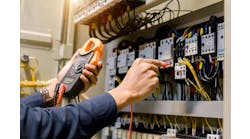Smaller companies can enjoy the benefits of scalable productivity with only a handful of employees.
Q: For integrators and machine builders who are still modifying enclosures by hand, what are the efficiencies that can be gained through automation?
A: There are significant gains in terms of reducing layout and labor time to be captured if you consider the typical process to modify one enclosure by hand:
- Apply a protecting covering on the enclosure to avoid scratching.
- Referring back and forth from the paper drawing, measure out where the modifications will go and mark the enclosure.
- Center punch each hole to help ensure the drill bit does not walk.
- For larger holes, you might use a punch and die system to create the hole so this will require assembly and disassembly of the punch and die for each hole.
- For areas with a cutout, use a jigsaw to remove the metal.
- If you are modifying a back panel with components installed, you would place the components on the panel, measure location based on paper drawing and then mark the mounting holes.
- Next drill and tap the mounting holes. Depending on the complexity of the modifications, modifying by hand could take 30-45 minutes. Now imagine doing this 5, 10, 25 or 50 times. And estimate how many opportunities there are for errors. Now if I automate this process with a Perforex machine we need to rethink the process.
How to use the modified drawings:
- We can program the modifications using the integrated 2D layout software in the Perforex machine interface.
- Simply import the drawing utilizing the effective and highly flexible DXF import capability of the machine software.
- Or the most efficient way of programming the machine is through EPLAN ProPanel 3D software.
- All three options allow all engineering-to-manufacturing documentation to be updated concurrently and stored in a single location, which in turn reduces errors and ongoing data maintenance costs.
Product manager, Rittal Automation Systems, Rittal North America
The modification:
- The machine operator loads the part onto the machine and securely clamps the parts.
- The machine operator loads the program and the Perforex machine starts drilling, tapping and milling the part based on the program. The Perforex machine then automatically changes tooling based on the program, lubricates the tooling to help ensure long tool life, and vacuums away metal shavings to reduce cleanup and avoid scratching the surface.
- Once the process is completed, the operator removes the part and repeats the same modification or moves on to the next modification program.
- The part is modified and completed within 3-5 minutes.
The automation advantages:
- Easy programing or drawing import into software.
- Manual layout of the enclosure/part is not required.
- Enclosure/part is modified quickly and accurately.
- Process can easily be repeated with high accuracy.
- The entire modification process is accelerated.
- Programs for modifications can be changed quickly for last minute design updates.
Q: At what scale does it make more sense to invest in in-house CNC capabilities?
A: Almost any company building control panels can benefit from the Perforex technology. Traditionally we talk about a two-year ROI based on about 250 control panels per year, but we have several customers who are building considerably fewer than that number.
Smaller companies can enjoy the benefits of scalable productivity with only a handful of employees. They realize much higher quality and repeatability. Small companies need to have their highly trained but limited staff concentrate on the other value-add activities which demand their time such as panel assembly, wiring and testing. Small variations in work volume can be very stressful for smaller companies, and automation like the Perforex can help them avoid painful layoffs or hiring temporary labor when demands are high.
Q: Heat dissipation often presents a dilemma. Where do climate control solutions fit into this automated machining future?
A: Heat is the enemy of electronics, so climate control is critical for control enclosures. To help ensure your Rittal Blue e+ air conditioners or chillers are running at peak performance, the Rittal IoT Interface can be used to network Rittal components with the customer’s own monitoring or energy management system. Data from the Rittal IoT Interface can be integrated into data collection, enable alarms, or send emails. On the front end of the design process, working in a databased environment allows for the panel designer to take the guess work out of layout and thermal calculations. Optimization starts with data found on Rittal’s website for climate products or on the EPLAN Data Portal.
Once downloaded and incorporated into the EPLAN project, the digital twin of all devices used in the panel already carry with them the necessary information for layout planning and climate device selection.
Both the device heat dissipation requirements and placement are visualized in a 3D environment to help ensure the most efficient sizing of the climate control device and placement on the enclosure to help ensure proper air flow. Under-sizing a climate control device can also lead to reduced service life of the components, and oversizing wastes energy and is taxing on the cooling device due to frequent cycling. The combination of 3D planning and Rittal’s RiTherm technology takes the guesswork out of selecting the correct cooling solution and its optimal placement on the enclosure.
The Rittal data can be downloaded to the Perforex software to help ensure accurate and easy modifications.
Q: Our understanding is that Rittal Automation Systems are actually enclosure-agnostic. For someone who is already on board with automated enclosure modification, what are the
benefits of also going with Rittal enclosures?
A: Rittal enclosure designs are ideal for use on the CNC machine. The following traits are all important to getting consistent and faster results in this automated process:
- Modularity. Doors, rearwalls, sidewalls and roofs can easily be removed so that you are only required to load and modify a single part, not struggle with trying to load an entire enclosure. Single parts are much lighter and easier to handle, which is faster and safer for a person to load onto a machine.
- Rittal’s automated manufacturing processes result in consistent product with high dimensional accuracy. Combined with the accuracy of the Perforex machine, the result is a part that has modifications exactly per the drawing.
- The modular parts have a rectangular design that allows for easy clamping on the Perforex machine.
- Mounting hardware is not welded to the enclosure body so it does not need to be considered in the clamping process. Toolless disassembly of mounted hardware such as door handles makes preparing the part for modification fast and simple.
- Rittal’s automated manufacturing processes result in consistent product with high dimensional accuracy. Combined with the accuracy of the Perforex machine, the result is a part that has modifications exactly per the drawing.
Certainly, other non-modular enclosure designs can be modified on the Perforex machines; but if you want to truly take full advantage of the process improvements the Perforex
machine can offer - you will want to switch to Rittal.
For more information, visit www.rittal.us




